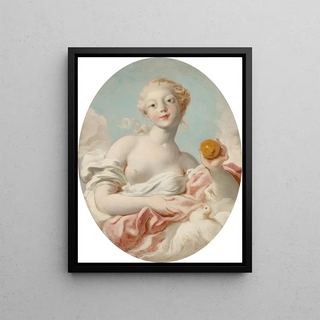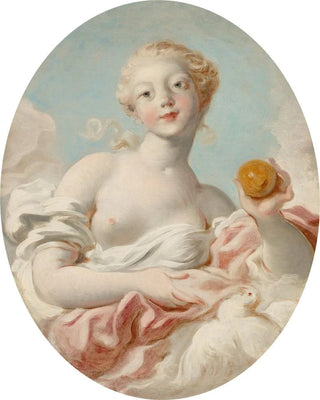Art print | Portrait known as Mademoiselle Marie-Catherine Colombe as Venus - Jean-Honoré Fragonard


View from behind

Frame (optional)
Portrait of Mademoiselle Marie-Catherine Colombe as Venus - Jean-Honoré Fragonard – Captivating Introduction
In the world of art, some works transcend mere visual representation to become witnesses of an era, stories of emotions, and reflections of a culture. The portrait of Mademoiselle Marie-Catherine Colombe by Jean-Honoré Fragonard, often referred to as "Portrait of Mademoiselle Marie-Catherine Colombe as Venus," embodies this essence. This piece, created in the 18th century, not only illustrates the beauty and elegance of its model but also evokes the values and aspirations of a society in full transformation. Fragonard, master of rococo, manages to capture an atmosphere of lightness and sensuality, inviting the viewer to immerse themselves in a universe where art and life seem to blend.
Style and uniqueness of the work
Fragonard's style is distinguished by its bold use of color and light. In this portrait, the delicate palette, dominated by pastel tones, creates a visual harmony that immediately draws the eye. The depiction of Mademoiselle Colombe, draped in light and flowing fabrics, evokes grace and femininity. The meticulous details, such as reflections in the hair and the texture of the clothing, testify to the artist's exceptional talent for capturing reality while adding an almost dreamlike dimension. The work is not limited to a simple portrait; it becomes a celebration of beauty and sensuality, where each brushstroke seems charged with emotion. Fragonard thus succeeds in immortalizing a fleeting moment, transforming an intimate scene into a lasting aesthetic experience.
The artist and his influence
Jean-Honoré Fragonard, born in 1732, is one of the most emblematic artists of the rococo movement. His prolific career is marked by an incessant exploration of themes of love, passion, and nature. Fragonard, a student of François Boucher, developed a style that is uniquely his own, combining lightness with emotional depth. His works, often imbued with a certain intimacy, invite the viewer to share moments of life, to

Matte finish

View from behind

Frame (optional)
Portrait of Mademoiselle Marie-Catherine Colombe as Venus - Jean-Honoré Fragonard – Captivating Introduction
In the world of art, some works transcend mere visual representation to become witnesses of an era, stories of emotions, and reflections of a culture. The portrait of Mademoiselle Marie-Catherine Colombe by Jean-Honoré Fragonard, often referred to as "Portrait of Mademoiselle Marie-Catherine Colombe as Venus," embodies this essence. This piece, created in the 18th century, not only illustrates the beauty and elegance of its model but also evokes the values and aspirations of a society in full transformation. Fragonard, master of rococo, manages to capture an atmosphere of lightness and sensuality, inviting the viewer to immerse themselves in a universe where art and life seem to blend.
Style and uniqueness of the work
Fragonard's style is distinguished by its bold use of color and light. In this portrait, the delicate palette, dominated by pastel tones, creates a visual harmony that immediately draws the eye. The depiction of Mademoiselle Colombe, draped in light and flowing fabrics, evokes grace and femininity. The meticulous details, such as reflections in the hair and the texture of the clothing, testify to the artist's exceptional talent for capturing reality while adding an almost dreamlike dimension. The work is not limited to a simple portrait; it becomes a celebration of beauty and sensuality, where each brushstroke seems charged with emotion. Fragonard thus succeeds in immortalizing a fleeting moment, transforming an intimate scene into a lasting aesthetic experience.
The artist and his influence
Jean-Honoré Fragonard, born in 1732, is one of the most emblematic artists of the rococo movement. His prolific career is marked by an incessant exploration of themes of love, passion, and nature. Fragonard, a student of François Boucher, developed a style that is uniquely his own, combining lightness with emotional depth. His works, often imbued with a certain intimacy, invite the viewer to share moments of life, to






